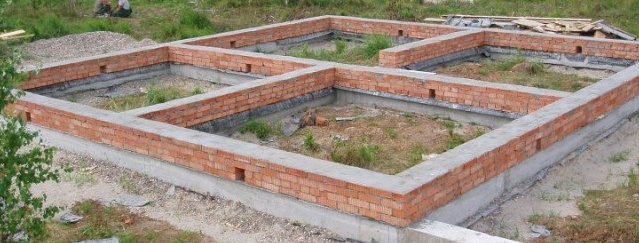Foundation reinforcement
The foundation is the foundation of the building. Its task is to receive and transfer the load from the building to the ground on which the building is being built. The most popular foundation made of concrete. However, concrete is not plastic, and, under the influence of a load on it, cracks.
To prevent the destruction of the foundation under the influence of various forces (building load, frosty heaving), reinforcement is intended. The principle of which is the location of the reinforcement inside the concrete foundation. The material from which the reinforcement is made is more resistant to stretching than concrete. Most often, metal is used for this. However, fiberglass reinforcement has appeared on the market of building materials, which has advantages over metal, since it is more durable, not subject to corrosion, more elastic, does not change its properties under the influence of low, or vice versa, high temperatures.
Foundation reinforcement is made using nets. Nets can be knitted or welded. Also, the industry produces finished nets, which are stacked in two layers. They necessarily reinforce the foundation near the surface, since this is the area of the foundation where the greatest tension occurs. The top layer of reinforcement should be located no closer than 5 cm from the surface so that it is protected from the influence of the external environment (this is especially important when using steel reinforcement).
Strip foundation reinforcement
When reinforcing the foundation, take into account the fact that the reinforcement of a larger diameter (if the side is up to 3 m - the diameter of the reinforcement is 10 mm, if the side is more than 3 m - 12 mm) should be located above and below, compared to the reinforcement located in the middle. This reinforcement should not have a smooth surface to provide better contact with concrete.
If reinforcement of a strip foundation is carried out, which has a width of about 40 cm, then for the sidewalls four rods of reinforcement with a diameter of 10-16 mm are used. The distance between the horizontal rods of the reinforcement is taken about 30 cm, between the vertical - from 10 to 30 cm. The distance depends on the conditions for laying the foundation (the depth of the foundation, the composition of the soil), as well as the future load on it. For a foundation with a width of 400 mm, the distance between the reinforcing bars in the horizontal plane should be about 300 mm, and in the vertical - in the range from 100 to 300 mm.
To reinforce the corner of the foundation, bent rods are used. The ends of the reinforcement must always be in the walls of the foundation. It is recommended to connect reinforcing bars using wire, since the strength of the reinforcement may be impaired during welding.
To reinforce the tile foundation, large-diameter reinforcement is used for both longitudinal and transverse rods, since the tile foundation has a large area and stresses can arise in it in any direction, and, besides, it can be twisted. When reinforcing a tile foundation, the distance between the reinforcement rods is 20–40 cm. When laying reinforcement with a step of 30 cm per square meter, about 14 m of reinforcement is consumed.



